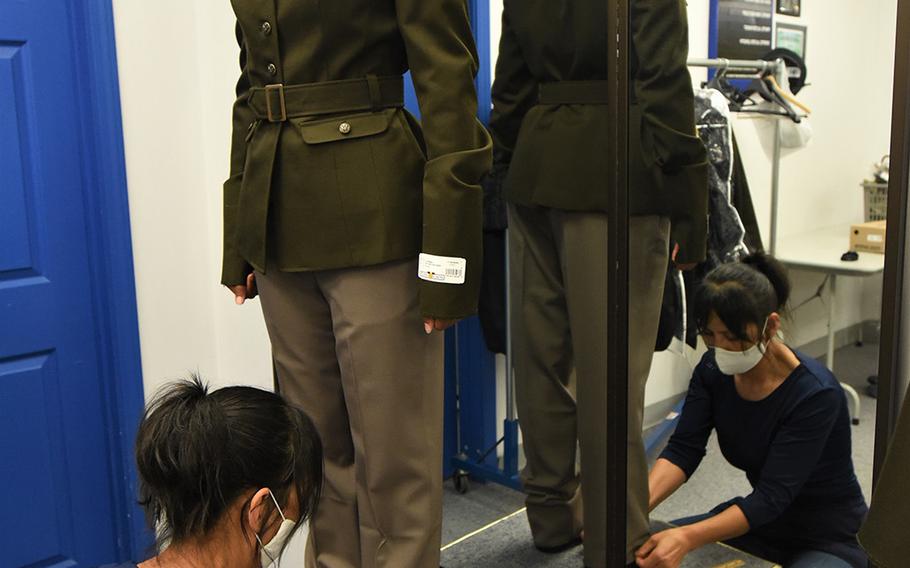
A female soldier attending the Army Recruiter Course at Fort Knox, Ky., has her pants hem measured by a seamstress after receiving the Army Green Service Uniform, July 8, 2020. (U.S. Army)
WASHINGTON — The U.S. Army this month will distribute its World War II-inspired green service uniforms to drill sergeants at installations hosting basic training as it begins its second round of the phased introduction, service officials said Tuesday.
By March, nearly all soldiers stationed worldwide should have the option to purchase the Army Green Service Uniform, said Army Col. Stephen Thomas, a project manager who led the Army’s development of the uniforms for Program Executive Officer Soldier. The Army greens — modeled after the popular “pinks and greens” uniform worn by officers during World War II — will slowly replace the blue Army Service Uniform as soldiers’ daily business wear, Thomas said. It will become mandatory in 2027.
Recruiting students Recruiting and Retention College in Fort Knox, Ky., received the uniform last month, and hundreds of soldiers with the Army Band and its 3rd Infantry Regiment, the ceremonial unit based in Arlington, Va., known as the Old Guard, have also received it. Some high-profile general officers and senior enlisted soldiers have been donning the new look around the Pentagon, during hearings on Capitol Hill and in other public appearances — including those conducted virtually — for several months.
Thomas said the feedback on the uniform he has received from soldiers has been overwhelmingly positive.
“Let me tell you, the Army is ready for this uniform,” Thomas told reporters in a phone call Tuesday. “I get constant positive feedback on the uniform’s appearance, and the next question I get after they say how good it looks is, ‘When can I get it?’ ”
The answer to that question, at least to some extent, remains to be determined, depending on a given soldier’s job and home station. Drill sergeants for Basic Combat Training and One-Station Unit Training at Fort Sill in Oklahoma, Fort Benning in Georgia, Fort Jackson in South Carolina and Fort Leonard Wood in Missouri will be issued the Army greens in the coming weeks.
By December, the Army plans to begin issuing the new uniforms to incoming recruits and to recruiters spread out across the country, Thomas said. It should be available for purchase in Army and Air Force Exchanges at all posts by spring, starting early next year at installations within the continental United States and then those in Hawaii, Alaska and overseas, he said.
Early adopters of the new uniform will pay more for it. The standard uniform now costs about $500, said Daniel Koglin, a military clothing manager for the Army and Air Force Exchange Service. That does not include any optional items available to soldiers, including the so-called “Ike” jacket, inspired by the cropped jacket made iconic by Gen. Dwight Eisenhower during World War II.
Thomas said over time the cost of the uniform will decrease as the Army ramps up production. Enlisted soldiers, he said, are encouraged to use their annual clothing replacement allotment to offset the cost of the new uniform. Officers will have to pay for it out of pocket.
Ultimately, the Army intends for the greens, or AGSUs, to become the standard everyday uniform for most soldiers working in an office-like setting. It will be required Oct. 1, 2027. The blue Army Service Uniform at that time will become standard for more formal occasions.
Thomas said the AGSUs were meant to last at least six years, as opposed to the four years the blue uniform is intended to be worn. They are also more form-fitting, especially for women.
For the first time in the Army’s history, Thomas said, the service took input from an all-female panel in designing the version of the uniform for women. Among the suggestions that group made were to make pants standard for female soldiers, as opposed to skirts.
“Because we want all of us, as soldiers, to look the same,” he said of their recommendation. “I thought that was pretty profound for that all-female board to come up with that decision.”
dickstein.corey@stripes.com Twitter: @CDicksteinDC